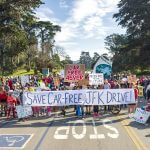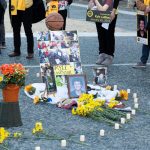Focusing enforcement on the most dangerous driving behaviors
Yesterday, I stood on Folsom Street holding a speed radar gun.
I was with a group of volunteers including District 6 Supervisor Matt Dorsey. As part of the Slow Our Streets campaign, we were out collecting data on how fast drivers were going around the SoMa neighborhood – home to many of the city’s most dangerous streets.
Not surprisingly, many drivers went far over the 25 MPH speed limit. And that brings a huge risk to all of us. The higher the speed, higher the chances are of a crash happening in the first place, as well as how severe the crash will be. Speed is the #1 cause of severe and fatal traffic crashes in San Francisco.
A lot can be done to change this – and most important is to design streets that make it difficult for drivers to go fast. We know that wide, multi-lane, one-way streets encourage fast driving, whereas two-way streets with fewer lanes, concrete dividers, and pedestrian safety fixes (like bulbouts, left turn calming, etc.) naturally slow drivers down. Speed limits are also important, and are now possible to lower on many more streets now thanks to a new state law we pushed for, Assembly Bill 43.
But there is a role for enforcement of deadly speed, especially when the stakes are so high when drivers don’t obey the law. This is why Walk SF has worked to pass legislation that would allow speed safety cameras in San Francisco. And it’s why we continue to look to the San Francisco Police Department to do their part.
Right now, enforcement of the top five most dangerous driving behaviors is near rock bottom. If you look at SFPD’s stats, the most recent month that’s available had just 152 “Focus on the Five” citations. That’s about 5 per day across the entire city.
Given the state of our streets, it’s maddening that traffic officers are spending any time on low-level, minor offenses like sleeping in a car, having a broken tail light, or tinted windows. These kinds of citations also can be racially-biased. They’re known as “pretextual stops” because they are used as a pretext to detail and search people. Unlike citations for dangerous driving behavior, pretext stops do not improve public safety.
Walk SF has been part of a coalition of 65 organizations that want to end biased, pretextual stops in San Francisco, which includes the ACLU of Northern California, All of Us or None, Council on American-Islamic Relations, GLIDE, Lawyers’ Committee for Civil Rights of the San Francisco Bay Area, Legal Services for Prisoners with Children, San Francisco Bicycle Coalition, San Francisco Public Defender, SPUR, and others. (This is a great piece on what we’re pushing for and why by SF Police Commissioner Max Carter-Oberstone).
In the dialogue around pretext stops, Walk SF has ensured dangerous driving behaviors are not removed from the pretext stops legislation – and continue to help shape the scope of what the revised city policy should be.
If you’re interested in this topic, I hope you’ll join me tonight at 6:00PM online for a community conversation about ending pretext stops.
And as always, reach out to me at jodie@walksf.org with your thoughts on enforcement. We will continue to push the SFPD to focus limited resources on the most dangerous driving behaviors as well as on the high-injury network: the 13% of streets where 75% of crashes occur.
Banner image by Raymond Wambsgans via Flickr Creative Commons




